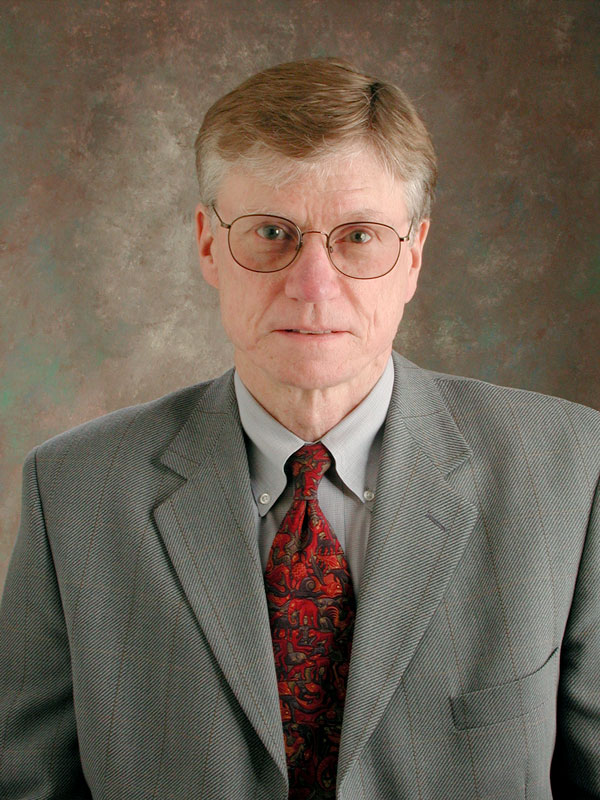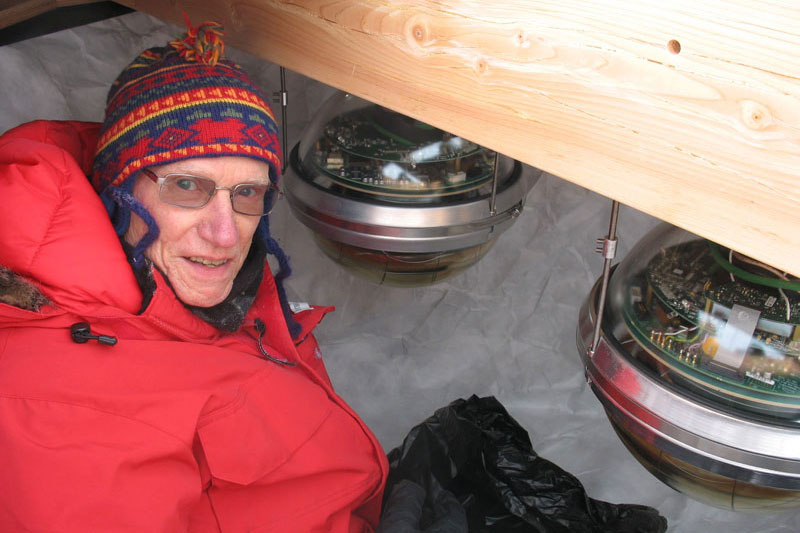

In Memoriam: Thomas K. Gaisser
Photos by Kathy F. Atkinson and courtesy of the IceCube Neutrino Observatory March 04, 2022
Colleagues remember renowned astroparticle physicist, Antarctic researcher
Thomas Korff Gaisser, the Martin A. Pomerantz Professor Emeritus of Physics at the University of Delaware and a leading theorist in the field of astroparticle physics, died Feb. 20, 2022, at his home in Swarthmore, Pennsylvania, three weeks before his 82nd birthday.
An internationally recognized giant in the field of cosmic ray and particle astrophysics, Dr. Gaisser was also the author of a textbook that has inspired generations of physicists and a leader who was instrumental in founding the scientific collaboration known as IceCube, which constructed and operates a neutrino observatory at the South Pole that has made many important discoveries. Among his numerous honors, a location in Antarctica is named Gaisser Valley.

In addition to his professional legacy, colleagues remembered Dr. Gaisser as kind and unassuming, generous in sharing his expertise and his time and in his enthusiastic support for young scientists. During his work at the South Pole, where he would spend weeks at a time, he especially enjoyed the camaraderie of everyone working on the project, his wife, Julia, said, calling it a high point of his personal and professional life.
“Tom was a great scientist, great member of the Department of Physics and Astronomy and Bartol Research Institute, and a consummate gentleman,” said Edmund Nowak, professor and chair of the department, where the Bartol institute is housed at UD. “He will be sorely missed.”
Dr. Gaisser earned his doctoral degree from Brown University in 1967 and held postdoctoral positions at Massachusetts Institute of Technology and Cambridge University. He joined the Bartol Research Foundation, now the Bartol Research Institute, which was then on the campus of Swarthmore College, in 1970. When Bartol moved to UD, Dr. Gaisser continued his work as a member of the research center faculty and in 2001 was named the University’s Martin A. Pomerantz Chaired Professor of Physics and Astronomy. He retired in 2019 and was awarded emeritus status.
His broad scientific focus allowed him to play a crucial and central role in the birth and development of the new field of astroparticle physics, which has emerged at the intersection of particle physics, astrophysics and cosmology. This field studies the emissions of photons, neutrinos and cosmic rays generated by astrophysical sources like supernova explosions, pulsars, black holes and others.
“During the years I served as director of Bartol, I became ever more aware of Tom’s stature in the fields of cosmic rays and particle astrophysics,” said Stuart Pittel, professor emeritus of physics and astronomy at UD, who has known Dr. Gaisser since the two were junior researchers at Bartol. Pittel recalled having dinner a few years ago with Saul Perlmutter, a Nobel laureate in physics, and mentioning that he had been the director of Bartol. “Ah,” Perlmutter said, “Tom Gaisser.”
Dr. Gaisser was “a pivotal researcher in the field of cosmic-ray physics” since the late 1970s, making “phenomenal” contributions, the IceCube consortium said in a tribute to him. “But the reason he is known to every scientist in the field, as well as to many others in physics, is his book Cosmic Rays and Particle Physics.”
That 1990 textbook has become standard reading for young researchers in the field and has been translated into Japanese and Mandarin. Dr. Gaisser, working with Ralph Engel and Elisa Resconi, published a second, updated and expanded, edition in 2016.

The author of some 150 articles in scientific journals, Dr. Gaisser was especially proud of one he wrote with his wife in 1977, “Partons in Antiquity,” published in the American Journal of Physics. Julia Gaisser said the idea for that article was her husband’s, but that he—typically, she noted—insisted on having her listed as the principal author.
Dr. Gaisser delivered numerous lectures around the world. In 2002 he was the Leverhulme visiting professor at Oxford University, and for many years was an adjunct professor of physics at the University of Utah. His outreach included serving as spokesperson for the IceCube consortium from 2007-2011 and a 2008 project in which he and other research team members at the South Pole sent online “Dispatches from the Frozen Frontier” for interested members of the public. In other years, he and UD invited teachers and their students to follow the expeditions online.
Dr. Gaisser was an elected Fellow of the American Physical Society and the recipient of the O’Ceallaigh Medal, the Humboldt Research Award, the National Science Foundation’s Antarctica Service Medal and the Homi Bhabha Medal and Prize for achievements over an extended career. He was the chair of the Commission 4 (Cosmic Rays) of the International Union of Pure and Applied Physics from 2000-2002 and a member of the American Astronomical Society and the Committee on Science and the Arts of the Franklin Institute.
“The honor that he would have prized most, however, is the deep affection and esteem of his colleagues around the world, including the many young scientists he befriended and encouraged over the years,” Julia Gaisser said.
About Thomas Gaisser
Dr. Gaisser was born in Evansville, Indiana, and graduated from Wabash College.
He won a Marshall Scholarship to study in England, where he earned a master of science degree at the University of Bristol. Traveling to England on the Queen Elizabeth, he met his future wife, also a Marshall Scholar. The two were married for 57 years.
He is survived by his wife, Julia; his son, Thomas Wolseley Gaisser and daughter-in-law Jeni; and by his grandchildren, Ethan and Anna Gaisser.
Funeral services will be private.
Prof. Gaisser will be remembered as a supportive mentor to many generations of early career scientists. This support will continue, thanks to a generous donation from Prof. Gaisser to the University of Delaware, which will be used to help establish a prestigious Bartol Research Institute Distinguished Postdoctoral Fellowship. In lieu of flowers, donations in memory of Thomas Gaisser may be made to UD’s Bartol Research Institute Research Scholar Support Fund, at this website.

Colleagues share their memories
Stuart Pittel, professor emeritus, Department of Physics and Astronomy: “Tom Gaisser was a dear friend and colleague of mine for over 50 years. It was always wonderful working with him. Tom was indeed the face of Particle Astrophysics and High Energy Cosmic Ray Physics at Bartol and at the University of Delaware, bringing enormous prestige to both. A wonderful scientist and a wonderful colleague, he will be greatly missed by me personally and by all who knew him and those who knew of him.”
Serap Tilav, scientist, Department of Physics and Astronomy, who was working with Dr. Gaisser on many projects until just a few weeks ago: “Tom Gaisser was a giant pillar in particle astrophysics we all leaned on. He will always be with us with his functions, formulas and methods which the field is built on. We will greatly miss his wisdom.”
Ralph Engel, head of the Institute for Astroparticle Physics in Germany who worked with Dr. Gaisser at Bartol as a former postdoctoral researcher and research scientist: “Tom has been one of the truly outstanding scientists in cosmic ray and, more generally, astroparticle physics. His work covers many fields, which he has typically shaped or helped to establish. … He will be sorely missed.”
Frank Schroeder, assistant professor, Department of Physics and Astronomy: “Tom Gaisser made it very easy for me to feel welcome and integrated when I joined the University of Delaware. In addition to all of Tom's physics achievements, he was a great person. I will miss having lunch with him and asking him for advice. Despite being retired, Tom was an active physicist until almost the last moment. He regularly joined our Bartol IceCube group meetings from home and continued to work on his own analysis.”
Jamie Holder, professor, Department of Physics and Astronomy: “Tom was a world-renowned scientist, and his impact on the field of cosmic rays and astroparticle physics was enormous, both through his scientific contributions, his leadership in the IceCube collaboration, and through his teaching and mentorship. His famous textbook on cosmic rays, in particular, inspired generations of physicists in the field, and continues to do so today. As a long-term member of the Bartol Research Institute, he embodied the Institute's mission to ‘foster excellence in research in physics and astronomy at the University of Delaware.’ Tom mentored me through the early stages of my career at UD, and I will personally miss his wisdom, his fairness, his dry wit and level-headed guidance. Anyone who had the opportunity to work with Tom would know him to be a great scientist, a generous colleague and a true gentleman.”
A former postdoc at Bartol: “I learned so much from him. I often thought of his high standards, integrity and kindness. He was the embodiment of ‘show not tell’ in how to be a good scientist.”
Tribute from the IceCube collaboration: “Tom Gaisser was both a leader and the person everyone could count on. A giant in the field of cosmic-ray and particle astrophysics. A giant supporting the next generation of scientists in the field. A giant, kind person and a founder of IceCube. This is how his friends and colleagues will always remember him.”
Contact Us
Have a UDaily story idea?
Contact us at ocm@udel.edu
Members of the press
Contact us at 302-831-NEWS or visit the Media Relations website

